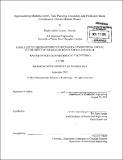Supernumerary Robotic Limbs : task planning, execution, and prediction-based coordination with the human wearer
Author(s)
Llorens-Bonilla, Baldin Adolfo
DownloadFull printable version (9.688Mb)
Alternative title
SRL : task planning, execution, and prediction-based coordination with the human wearer
Task planning, execution, and prediction-based coordination with the human wearer
Other Contributors
Massachusetts Institute of Technology. Department of Mechanical Engineering.
Advisor
H. Harry Asada.
Terms of use
Metadata
Show full item recordAbstract
Full automation of repetitive and/or specialized tasks has become a preferred means to meet the needs of manufacturing industries. However, some tasks cannot be fully automated due to their complexity or the nature of the work environment. In such cases, semi-automation through human-robot collaboration is a strong alternative that still maintains a high level of efficiency in task execution. This thesis focused on the control and coordination issues of the Supernumerary Robotic Limbs (SRL); a pair of wearable robotic limbs that are a potential solution to these issues. The first purpose of this study was to adequately model the collaborative aspect of a task that is conventionally performed by two coworkers. This was achieved through the Coloured Petri Nets (CPN) tool, which was able to model the collaboration between two coworkers by using the SRL and its operator instead. The second purpose of this work was to evaluate how to implement a sensor suit to establish reliable communication between the SRL and its operator. Using data-driven methods for detection, we were able to monitor the operator's current state. By combining this data with the CPN task model we were able to relay the operator's intentions to the SRL. This enabled the SRL to follow the CPN process model in a timely and coordinated manner together with its operator. The third and final section of this thesis focused on considering the interchangeability of roles between the SRL and its operator. We used a datadriven approach to model a task where the SRL and its operator had to perform a simultaneous dynamic task. This was performed by using teach by demonstration techniques on process data from two workers. A control algorithm was then extracted from the actions of the supporting worker. Both the process model and the sensor suit, together with the detection algorithms, were implemented and validated using the first prototype of the SRL. Results show that the SRL was successful in autonomously coordinating with its operator and completing an intercostal assembly task.
Description
Thesis: S.M., Massachusetts Institute of Technology, Department of Mechanical Engineering, 2013. Cataloged from PDF version of thesis. Includes bibliographical references (pages 87-89).
Date issued
2013Department
Massachusetts Institute of Technology. Department of Mechanical EngineeringPublisher
Massachusetts Institute of Technology
Keywords
Mechanical Engineering.